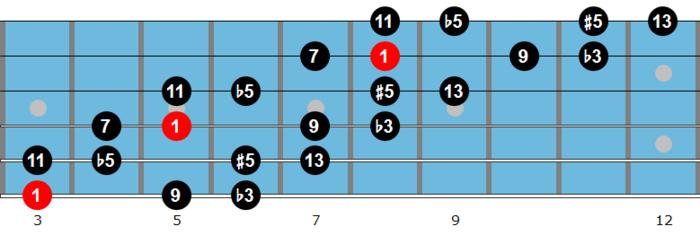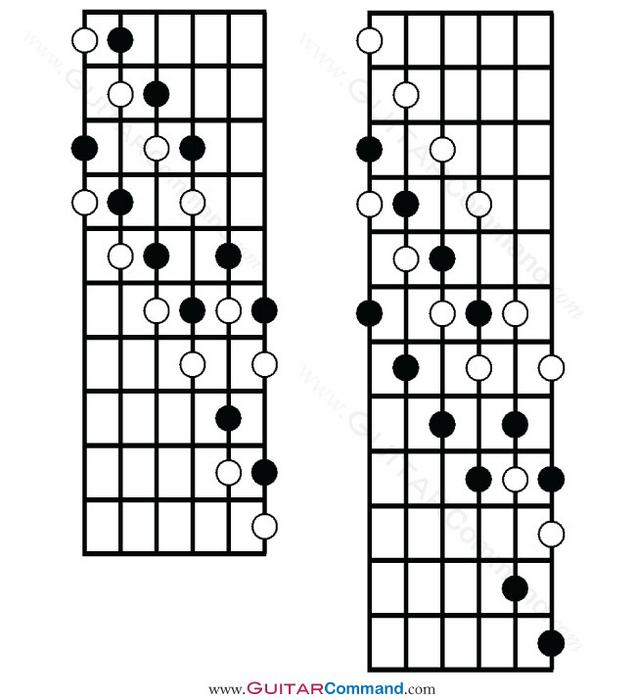Imagine this: you’re a dedicated guitarist, leafing through scales, when suddenly, you stumble upon the enigmatic ‘diminished scale’. You strum its unfamiliar progression and a mesmerizing, tension-filled melody envelops the room. It’s so captivating and unusual; a melodious departure from the other scales you know. Trembling with excitement, you wonder, “How can I master this intriguing scale?”
During my Master’s in Contemporary Improvisation, amidst several scales, one that stuck was indeed the ‘diminished scale’. Endowed with a peculiar charm, it triggered many improvisations that hold a special place in my sonic journey. Like courting a mysterious lover, we shall unravel this scale’s unique patterns, licks, and chords together; demystifying its complexities, while reveiling in its ethereal charm.
So, brace yourself for an enlightening journey into the depths of the ‘diminished scale guitar’. With my expertise, we’ll reveal the scale’s potential, transforming you into a virtuoso of tension and harmony.
Understanding the Diminished Scale
Whole-Half and Half-Whole Diminished Scales

As we delve into the realm of the whole-half and half-whole diminished scales, it’s important to remember just how vital this knowledge is to your musical progression. Being a seasoned music transcriber, I’ve spotted these scales providing the backbone to countless memorable solos. My experience has taught me that understanding the difference between these two variations can translate into significant improvements in your improvisation capabilities. The whole-half diminished scale has a unique symmetry that lends itself excellently to jazz and traditional improvisation, and the half-whole diminished scale holds potency in creating that much-desired tension, especially for blues and rock genres. Uncover these deep, complex soundscapes as you continue on your journey to master the diminished scale.
Using the Diminished Scale in Solos
Creating Tension with the Diminished Scale

Enriching your solo with the diminished scale can certainly ratchet up the tension in your music. As a point of personal interest, I’ve delved deeper into using the diminished scale for this purpose across various writings and lessons. Drawing upon this experience, I’ve discovered that the inherent suspense of the diminished scale naturally lends itself to building tension. Its unique pattern with an undercurrent of discord creates a sound that’s intriguing and yet somewhat unsettling. This effect, when employed judiciously, can make your solos resonate with a dramatic tension that remains etched in memory long after the chord has faded.
Solo Patterns and Licks

Building on our previous sections, let’s intimately explore solo patterns and licks which utilize the diminished scale. Having transcribed innumerable jazz guitar solos, I’ve noticed some deeply intriguing patterns and licks crafted using the diminished scale. The truly magical element here is how these licks seamlessly weave tension and release into a solo. They’re not just signifiers of technical prowess, but crucial tools for emotional expression. Improving your handle on these will significantly enhance your ability to solo using the diminished scale. So, why wait? Let’s dissect the beauty and complexity of these patterns and licks.
Exercises to Practice

Diving headfirst into ‘Exercises to Practice’ now, I want to share with you strategies that I’ve honed over years of teaching. Exercise and practice – the twin essentials for mastering any skill and in the music world, they hold paramount significance.
So how can you apply and practice the diminished scale to make it second nature? Here’s what generations of guitar players and pedagogy have taught me.
Start with speed exercises. By training your fingers to move swiftly and effortlessly across the fretboard, you’ll build the fluidity necessary for diminished scales. Next, is pattern recognition. This becomes key when we apply these scales in different situations.
Once comfortable, we embark on more intricate exercises like interval skips and string skipping. These proficiency exercises keep your fingers nimble while forcing your mind to remain one step ahead of your hand.
Finally, the savviest tip to mastering diminished scales: set aside time for focused practice. Uninterrupted, dedicated hours to grinding out these exercises will do wonders for your skill set.
Remember, proficiency doesn’t come overnight. It is an amassment of relentless practice and unwavering commitment. In the following chapter, we will explore how the diminished scale finds application in various chord situations. Sensitize your fingers, cogitate the scales, practice till it becomes instinctual.
The Diminished Scale in Chord Situations
Bridging Blues Changes with the Diminished Scale

In my book ‘Color Your Chords’, one method I discussed to bridge blues changes was through the use of the diminished scale. You’ll appreciate how it amplifies diversity and complexity in chord structures, presenting an exquisite, expressive detour for your blues progression. Bridging blues changes with the diminished scale not only elevates the tonal richness of your performance but also refines your comprehension of harmonic relationships within the guitar fretboard. It’s an underrated but definitive pivot from the usual, potentially propelling your blues into a fusion of engaging, resonant sound textures.
Step-by-Step Tutorial

Just as we’ve explored the foundations of the diminished scale, now is the time to apply everything we’ve learned. This tutorial will be far more than technical lessons on a page; it’s a journey born of our collective passion for guitar mastery.
I’ll take you through this step-by-step, based on my own experiences and the valuable lessons I’ve learned along my musical journey. Let’s not just understand the diminished scale – let’s feel it, breathe it, and transform it into a unique expression of our musical influence.
Ready for a deep dive into the diminished scale with hands-on practice? Let’s delve into precision, perfection, and your unparalleled musical performance. I’ll ensure that every aspect of what we’ve learned becomes second nature to you. From solo patterns and licks to building tension, every concept will find a place in your hands, your strings, and your heart.
We’ll analyze real-life chord situations, and bridge blues changes using the diminished scale to create dynamic solos. This is more than just theory – it’s the essence of living, breathing guitar music. I am thrilled to guide you on this journey and can’t wait to hear about your own unique experiences with the diminished scale.
Treat this tutorial as an open reception of knowledge, just as you would a live jamming session. Embrace the process and enjoy each step as you bring your musical aspirations to life, one note at a time.
Supplementary Jazz Guitar Lessons

After an insightful journey through the intriguing landscape of the diminished scale, it’s time to tie it all together with a cherry on top, namely, the ‘Supplementary Jazz Guitar Lessons.’ These lessons, inspired by my years of experience as the editor of ‘Acoustic Guitar’ magazine, serve as an excellent addendum to make your path smoother.
If you’re finding the diminished scale as mesmerising as I did when I first learned it, I’ve got something irresistible for you. Interested in taking this further with jazz influence? I’ve got just the right thing for you. These additional lessons offer a unique jazz-tinged approach, expertly curated from my extensive professional interactions and experiences.
These supplementary jazz guitar lessons will propel your understanding of the diminished scale to greater heights. You’ll fine-tune your understanding of patterns, licks, and chords within the jazz genre. You’ll grasp the art of creating tension with the diminished scale and effortlessly deploying it for solos and chord situations.
By delving into these lessons, you invite yourself to unlock a more profound comprehension of the guitar, the diminished scale, and, ultimately, the magical world of music. The notions you learn here have the power to bring your musical imaginings to life. So, let’s dive deeper, expanding our horizons one jazz guitar lesson at a time!
Frequently Asked Questions
What is the Diminished Scale in Guitar?
How to play a Diminished Scale on a Guitar?
What are common patterns in the Diminished Scale?
Which chords go well with the Diminished Scale?
Conclusion
As we conclude our journey into the intriguing world of the diminished scale guitar, it’s clear that it’s a uniquely powerful tool for any budding guitarist. From understanding its pattern, utilizing it in solos, creating tension, to weaving it into chord situations and jazz music, the scale’s peculiarities have become fascinating.
So, ready to incorporate the diminished scale into your guitar toolkit? Now is the time to take action! Revisit these lessons and trusted exercises. Explore the scale in solos, experiment with tension, and, of course, bravely bridge those blues shades. Your dedicated practice will lead you to add color to your guitar palette, enhancing your musical expression.
Remember, the magic and power of the diminished scale guitar lies within your fingers, waiting to be unfolded. Trust the process, stick to the lessons learned, and let the beauty of music continue to guide your journey.